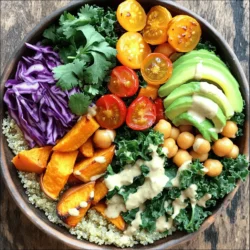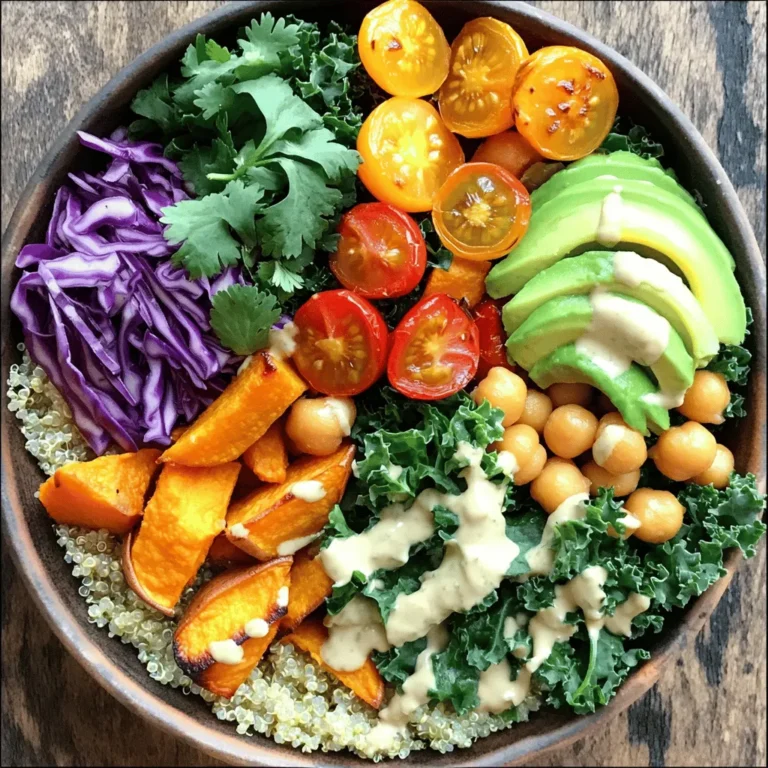Looking for a meal that’s both delightful and packed with nutrition? A Vegan Buddha Bowl might be just what you need! I’ll walk you through easy steps to create your own colorful, flavorful bowls using simple ingredients. Discover how to mix and match grains, veggies, and toppings that give you satisfaction in every bite. Let’s dive into the world of plant-based goodness together!
Ingredients
Essential Ingredients for a Vegan Buddha Bowl
For a Vegan Buddha Bowl, you need simple, fresh items. Here is your shopping list:
– 1 cup quinoa, thoroughly rinsed
– 2 cups vegetable broth (low-sodium recommended)
– 1 can (15 oz) chickpeas, drained and rinsed
– 1 medium sweet potato, peeled and diced into 1-inch cubes
– 1 cup kale, stems removed and chopped into bite-sized pieces
– 1 ripe avocado, sliced
– 1/2 cup cherry tomatoes, halved
– 1/4 cup red cabbage, finely sliced
– 2 tablespoons tahini
– 2 tablespoons freshly squeezed lemon juice
– 1 tablespoon pure maple syrup
– 1 teaspoon garlic powder
– 1 teaspoon smoked paprika
– Sea salt and freshly ground black pepper to taste
– Fresh cilantro leaves, for garnishing
Nutritional Highlights of Each Ingredient
Each ingredient brings its own benefits. Here’s what they offer:
– Quinoa: High in protein and fiber. It is a complete protein source.
– Chickpeas: Packed with protein and help keep you full longer.
– Sweet Potato: Rich in vitamins A and C for healthy skin and eyes.
– Kale: Loaded with vitamins K, A, and C. Great for bones and immune health.
– Avocado: Contains healthy fats that are good for your heart.
– Cherry Tomatoes: Full of antioxidants. They help fight inflammation.
– Red Cabbage: High in vitamins and has anti-cancer properties.
– Tahini: Made from sesame seeds, it provides healthy fats and protein.
– Lemon Juice: Rich in vitamin C, which boosts your immune system.
– Maple Syrup: A natural sweetener that offers some minerals.
Recommended Alternative Ingredients
You can swap ingredients based on your taste or what you have. Here are some ideas:
– Quinoa: Use brown rice or farro for a different grain.
– Chickpeas: Try black beans or lentils for added protein.
– Sweet Potato: Substitute with butternut squash or regular potatoes.
– Kale: Spinach or Swiss chard work well as leafy greens.
– Tahini: Use peanut butter or sunflower seed butter if needed.
– Lemon Juice: Lime juice can add a nice twist to your dressing.
Feel free to mix and match based on your preferences. This recipe is flexible, making it fun to create your perfect bowl!
Step-by-Step Instructions
Preparation Techniques for Each Ingredient
Start by rinsing your quinoa well. This removes bitter saponins and makes it taste better. Drain the quinoa thoroughly to avoid excess water. Next, peel and dice your sweet potato into 1-inch cubes. This size helps them cook evenly. Remove the stems from the kale and chop it into bite-sized pieces. For the cherry tomatoes, simply slice them in half. Finally, slice your avocado right before serving to keep it fresh and green.
Cooking Quinoa to Perfection
To cook quinoa, use a medium saucepan. Bring 2 cups of vegetable broth to a boil. Then, add your rinsed quinoa. Cover the pot and reduce the heat to low. Let it simmer for about 15 minutes. After that, check if all the liquid is absorbed. The quinoa should look fluffy. Remove it from the heat and let it sit for 5 more minutes, covered. This step gives it a great texture.
Roasting Sweet Potatoes: Tips for Optimal Flavor
Preheat your oven to 425°F (220°C). Spread the diced sweet potatoes on a lined baking sheet. Drizzle with olive oil. Sprinkle garlic powder, smoked paprika, salt, and pepper over them. Toss the sweet potatoes well to coat them evenly. Roast for 20-25 minutes, flipping halfway through. They should be tender and golden brown. This roasting brings out their natural sweetness.Enjoy the vibrant flavors and textures in every bite!
Tips & Tricks
How to Make Your Buddha Bowl Visually Appealing
To make your Buddha bowl pop, use bright colors. Arrange the ingredients in sections. Each color adds beauty and invites eating. Use a variety of textures, like crunchy cabbage and creamy avocado. Choose contrasting bowls that enhance the colors of your meal.
Ideal Dressings and Toppings for Added Flavor
Dressings can elevate your bowl. A tahini dressing works well. Mix tahini, lemon juice, and maple syrup for a sweet and tangy taste. You can also add a drizzle of balsamic glaze for a rich touch. For crunch, sprinkle sesame seeds or chopped nuts. Fresh herbs like cilantro or parsley can add brightness.
Meal Prepping Tips for Busy Days
Meal prep saves time. Cook a large batch of quinoa and store it in the fridge. Roast sweet potatoes ahead and keep them in an airtight container. You can assemble your bowl quickly on busy days. Keep toppings like avocado and tomatoes fresh by adding them just before serving. This way, your meal stays colorful and tasty.

Variations
Different Grain Options for Your Bowl
You can use many grains in your Buddha Bowl. Quinoa is great, but you can switch it up. Try brown rice for a chewy texture. Farro adds a nutty flavor, while barley brings a hearty bite. You can even use millet or couscous for a unique twist. Each grain offers different nutrients and flavors to explore.
Protein Alternatives for Added Nutrition
Chickpeas are a fantastic protein source. If you want more options, consider black beans or lentils. Edamame is another quick choice full of protein and flavor. You can also use tempeh or tofu for a meatier texture. Adding nuts or seeds can give your bowl an extra protein boost while adding crunch.
Seasonal Vegetable Suggestions for Freshness
Incorporating seasonal veggies makes your Buddha Bowl fresh and colorful. Use asparagus or peas in spring. Summer brings ripe tomatoes and zucchini. In fall, roasted pumpkins or butternut squash shine. Winter is perfect for hearty greens like kale or Swiss chard. Choose what’s freshest to enjoy the best flavors and nutrients.
Storage Info
Best Practices for Storing Leftovers
Store your Vegan Buddha Bowl leftovers in an airtight container. This will keep the food fresh. Place the quinoa, veggies, and dressing in separate containers. This helps maintain texture and flavor. Use the leftovers within three days for the best taste. If you have extra roasted sweet potatoes, they can last for about four days in the fridge.
Freezing Options for Buddha Bowl Ingredients
You can freeze some Buddha Bowl ingredients for later use. Quinoa freezes well. Just let it cool, then place it in a freezer-safe bag. It can last for up to three months in the freezer. Roasted sweet potatoes also freeze nicely. You can freeze them on a baking sheet first, then transfer to a bag. Chickpeas can be frozen too. Just drain, rinse, and dry them before freezing.
Reheating Tips to Retain Flavor and Texture
When reheating, avoid using the microwave if possible. Instead, use a skillet on low heat. Add a splash of water to help steam the ingredients. This keeps your bowl moist and flavorful. For quinoa, you can reheat in a saucepan with a bit of water. Stir occasionally until heated through. If you have dressing left, drizzle it on after reheating to keep it fresh.
FAQs
What is a Vegan Buddha Bowl?
A Vegan Buddha Bowl is a colorful meal in a bowl. It includes grains, veggies, and protein. You can mix any plant-based ingredients you love. This dish is healthy, filling, and visually appealing. It often has a base of grains like quinoa or brown rice. Then, you add roasted or fresh vegetables. You can also include legumes, nuts, or seeds for protein. A tasty dressing pulls it all together. Each bite is a delightful mix of flavors and textures.
How to make a vegan Buddha bowl with leftover ingredients?
You can easily create a vegan Buddha bowl with leftovers. Start with a base of grains, like rice or quinoa. Look for leftover veggies in your fridge. Roasted or fresh, any leftover vegetables work well. You can also add beans or lentils for protein. If you have nuts or seeds, sprinkle them on top for crunch. For a dressing, mix olive oil, lemon juice, and your favorite herbs. This way, you use what you have while making a tasty meal.
What can I use instead of tahini in my dressing?
If you don’t have tahini, try these easy swaps. Almond butter or peanut butter can work well. They give a nutty flavor and creamy texture. You can also use sunflower seed butter if you’re nut-free. Greek yogurt is another option for a creamy dressing. If you want a lighter option, use avocado or a simple vinaigrette. Mix lemon juice, olive oil, and a bit of maple syrup. This will add flavor without tahini.
In this blog post, I explored how to build a tasty vegan Buddha bowl. We covered key ingredients, helpful cooking tips, and fun variations. You learned how to use different grains and proteins for better nutrition. You can make your bowl attractive with the right dressings and toppings.
Finally, remember that meal prep can make your week easier. A vibrant Buddha bowl not only nourishes but also excites your taste buds. Enjoy creating and customizing your own bowl!


